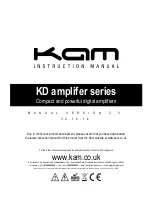
The Technical Stuff
_____________________________________________________________
20
Input Signal and Threshold
The first and perhaps most significant factor in compression is the level of the input signal. Large
(loud) input signals result in more gain reduction, while smaller (softer) input signals result in less
gain reduction.
Threshold
is another important factor. It is a term used to describe the level at which a
compressor starts to work. Below the threshold point, the volume of a signal is unchanged; above it,
the volume is reduced. For example, if a compressor’s threshold is 0 dB, incoming signals at or above
0 dB will have their gain reduced, while those below 0 dB will be unaffected.
In the 1176LN, the Input
knob controls both the threshold and the amount of input signal being routed
to the gain reduction circuitry. As it is turned up (clockwise), the overall degree of compression
increases; as it is turned down (counterclockwise), the overall degree of compression decreases. Note
that the 1176LN ratio setting also affects threshold (see below).
Ratio
Another important term is compression
ratio
, which describes the amount of increase required in the
incoming signal in order to cause a 1 dB increase in output. A ratio of 1:1 therefore means that for
every 1 dB of increase in input level, there is a corresponding 1 dB increase in output level; in other
words, there is no compression being applied. A ratio of 4:1, however, means that any time there is an
increase of 4 decibels in the loudness of the input signal, there will only be a 1 dB increase in output
signal. A ratio of 8:1 means that even when there is a full 8 decibels of increase in loudness, there will
still only be a 1 decibel increase in output signal. (Bear in mind that the decibel is a logarithmic form
of measurement, so a 2 dB signal is not twice as loud as a 1 dB signal; in fact, it requires
approximately 10 dB of increased gain for a signal to sound twice as loud.)
As you can see from this illustration, at low ratios of 2:1 or 4:1, a compressor has relatively less effect
on the incoming signal; at higher ratios, it has more effect. While the terms “compression” and
“limiting” are often used interchangeably, the general definition of compression is gain reduction at
ratios below 10:1; when higher ratios (of 10:1 or greater) are used, the process is instead called
limiting
. Limiters abruptly prevent signals above the threshold level from exceeding a certain















































